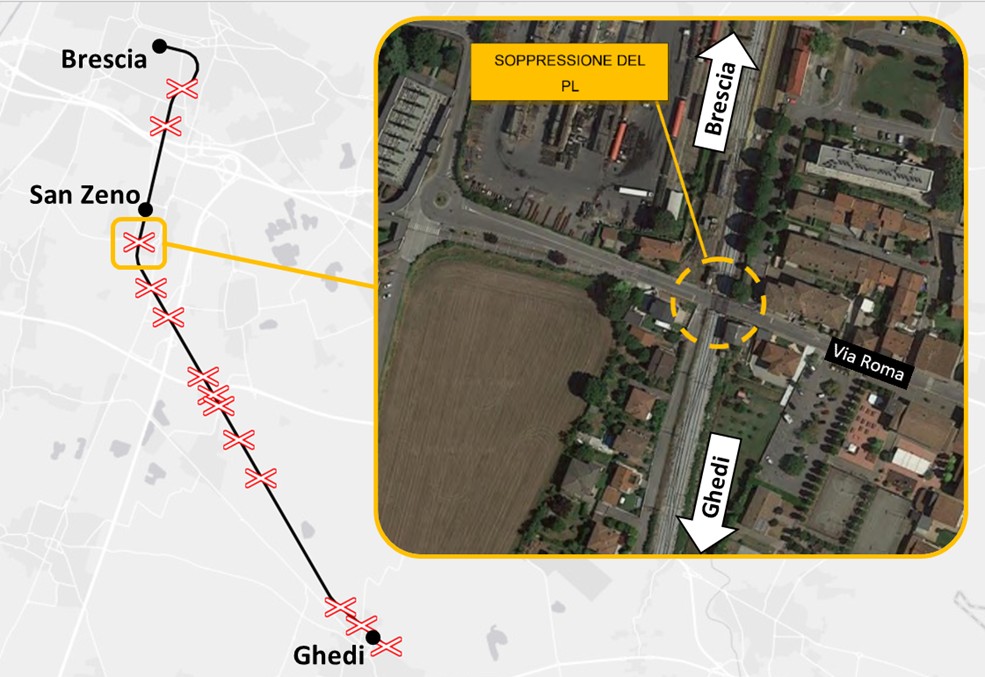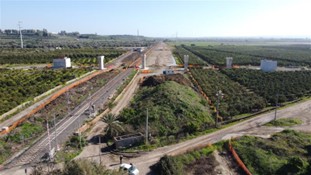
A Level Crossing (PL), occurs where a road and railway tracks intersect on the same level, and poses a safety risk for both road and rail traffic, as it involves road and rail vehicles sharing the space. For this reason Gruppo FS Italiane has been engaged in an ambitious programme for some time, related to doing away with many of the level crossings found nationwide.
This action of doing away with level crossings aims not only to improve rail and road safety, but also to optimise railway service efficiency, while ensuring better road traffic flow. Italferr plays an active part in this process, implementing design solutions that combine sustainability and innovation, able to ensure efficient traffic systems that meet the needs and provide for the wellbeing of local communities.
Traffic efficiency and reduction of waiting times
Besides safety, one of the basic aims of the projects for Doing Away With Level Crossings is to reduce waiting times for toad traffic, while improving railway flows. Optimisation of road traffic reduces not only fuel consumption and emissions resulting from engines running, but also noise pollution and inconvenience for citizens. This translates into a significant reduction in time with engines running, contributing to an overall improvement in living standards in urban settings, with less disturbance in out of town zones. Specifically, the creation of underpasses and overpasses does away with areas in which road and rail traffic are in conflict, while also reducing the acoustic impact of warning signals and idling engines of waiting vehicles.
Emission reduction and improvement of air quality
In addition, doing away with Level Crossings is an effective way of reducing greenhouse gas emissions and atmospheric pollutants caused by stopping times and starting up again at a Level Crossing. The flows guaranteed by works to do away with Level Crossings contribute to reducing fuel consumption and the emission of particles, NOx and greenhouse gases, improving air quality, especially in urban areas.
Carbon Footprint evaluation of works to do away with Level Crossings
Italferr applies advanced methods for calculating the Carbon Footprint associated with doing away with Level Crossings and constructing alternative traffic infrastructures. Assessment of the climatic impact takes various factors into account, including materials, transportation and the works required to resolve interference at road level (underpasses, viaducts, etc.), guiding technicians to more sustainable alternatives during the design process.
An analysis of the projects to do away with Level Crossings carried out thus far showed that, on average, these works generate about 4,000 tonnes of CO2e in direct emissions, with a total impact of the order of about 40,000 tonnes of CO2e. These results vary mainly in relation to the complexity of the works designed, and the territorial context in which they are located. For example, higher greenhouse gas emissions can be associated with more isolated settings, due to greater transportation distances for getting to the worksites and delivering materials. Nevertheless, the overall benefits highlighted in the previous paragraphs partly or fully make up for these climatic costs, depending on the specifics of the project.
Life Cycle impacts
In terms of Life Cycle Thinking, it is important to point put that doing away with level crossings improves railway line maintenance. As shown by the LCA (Life Cycle Assessment) studies done by Italferr on transport infrastructures, acting during this life cycle phase is a significant factor in reducing the overall impact of the works. In fact, Level Crossings are made up of mechanical components that, by their very nature, are subject to wear and require frequent maintenance. These works, often required to ensure correct operation, may result in planned and unexpected interruptions in train traffic.
Doing away with Level Crossings therefore simplifies technical management of the infrastructure, significantly reducing long-term maintenance works, while improving overall line availability. This is not merely an immediate benefit, it is also a long-term structural advantage, significantly contributing to the infrastructure's sustainability and efficiency over its entire life cycle.
A Concrete Example: the Brescia – San Zeno – Ghedi route and Lot 6 of the Palermo - Catania Line Doubling
One concrete example of this approach is the project to do away with the 13 Level Crossings currently in place on the Brescia – San Zeno – Ghedi route. Some of these Level Crossings, which are located in densely urbanised areas, called for a design taking local needs into account, while searching for solutions that could guarantee safety, smooth traffic flows, and sustainability. Replacement works were therefore designed, such as underpasses and overpasses, able to do away with road - rail intersections, while ensuring access points within the urban fabric. Particular care was also taken over the environmental impact at the design stage, promoting the use of low impact materials and innovative construction techniques.

Soppressione del PL attualmente presente in Via Roma, San Zeno

Another example is doubling of the Palermo - Catania line. The lot 6 design area did away with 14 level crossings, most of which were located in out of town contexts. Overpass works were opted for when it came to constructing the replacement routes.
These works have already been completed, with Direction of Works by Italferr, thereby demonstrating Gruppo FS's real commitment to sustainability.
A constant commitment to guaranteeing greater safety and smoother traffic flows for future infrastructures
Gruppo FS and Italferr are actively engaged in increasing the safety of railway infrastructures, with a view to improving the efficiency of traffic flows, providing a railway network that is safer and more sustainable, in the form of tangible actions.